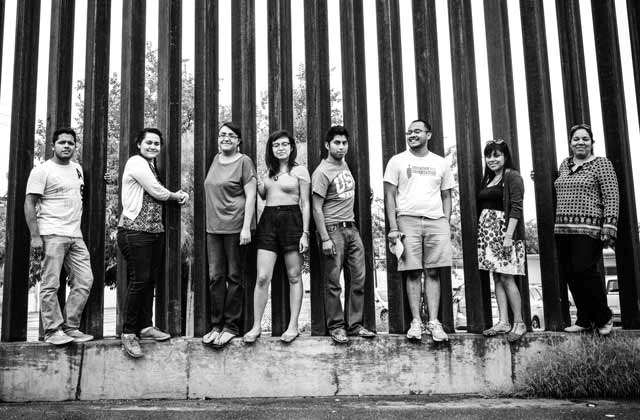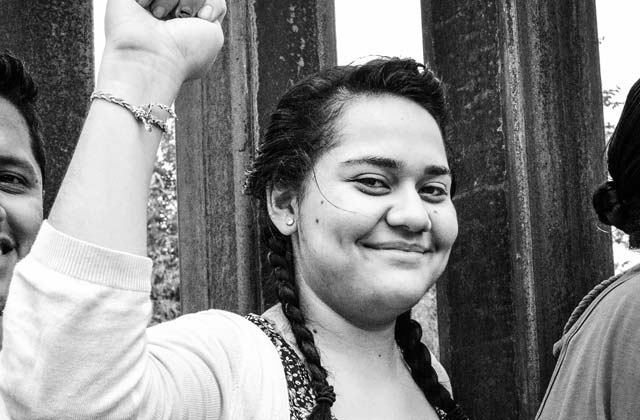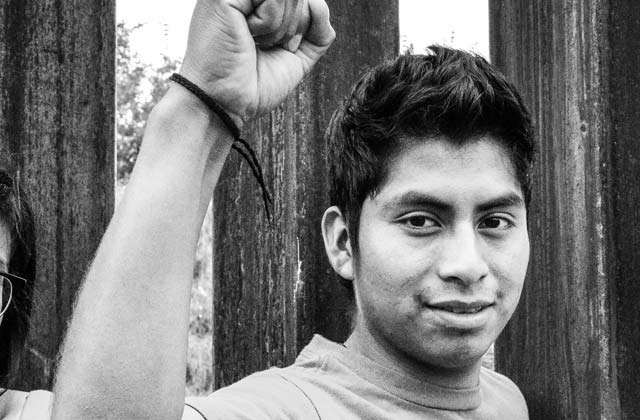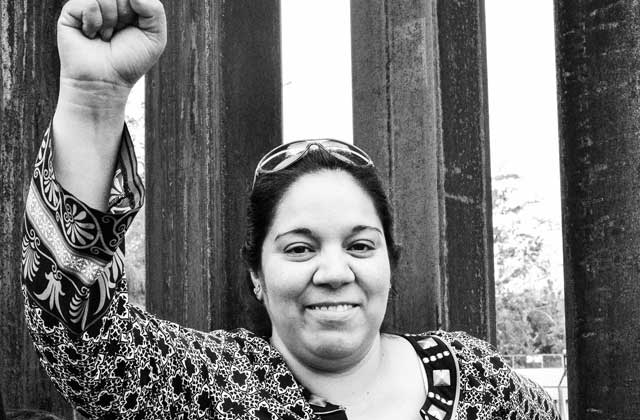The Dream 9, One Year Later
by Aura Bogado
One year ago today, a group that would come to be known as the Dream 9 crossed from Mexico into the United States at a port of entry in Nogales, Ariz. The crossing was remarkable in that it was a highly publicized event in which a group of people—almost all of them in their 20s—demanded to enter and sought either humanitarian parole or asylum. The action, which trended as #BringThemHome on social media, was organized by the National Immigrant Youth Alliance (NIYA), which went on to organize larger border crossing actions later in the year.
Three of the Dream 9, Lizbeth Mateo, Lulú Martínez and Marco Saavedra, were undocumented activists who left the relative safety of the United States in order to go to Mexico and pick up five people who had previously lived in the U.S.:Adriana Díaz, Ceferino Santiago, Claudia Amaro, Luis Leon and María Inéz Peniche. One more, Mario Félix, joined them at the last minute as they crossed into the United States.
All nine were detained by Border Patrol and soon taken to the Eloy Detention Center, a private detention center in Arizona operated by the Corrections Corporation of America (CCA). The Dream 9 spent about 2 1/2 weeks in detention before they were released following approval of their credible fear applications.
One year later, the Dream 9 have all returned to their respective communities throughout the United States and they’re preparing to head to court to make their individual claims for asylum. We checked in with three of the nine one year after their decision to cross the border as a political act.
María Inéz Peniche, 23
María Inéz Peniche came to the United States from Mexico when she was 10 years old and grew up in Boston. She was 17 when she found out that she was undocumented and soon saw opportunities disappearing as a result. Her family—including both her parents and her brother—made the decision to return to Mexico City, Mexico, in 2012, just three days before President Obama announced the Deferred Action for Childhood Arrivals program, from which Peniche would have benefited.
Life in Mexico was difficult for Peniche. She wanted to attend Mexico City’s top university but couldn’t because she didn’t know enough about Spanish language literature and Mexican politics to pass the entry exam. She was sexually harassed by employers but felt pressure to keep working to help her family financially. After getting in touch with the NIYA, Peniche had one day to make the decision to join the action, and despite her family’s warnings, she wanted to try to return.
Along with Lulú Martínez, Peniche staged an action inside of Eloy’s mess hall; they were sent to solitary confinement as a result. Peniche spent 15 days with minimal human contact and was only allowed two 10-minute showers a week. She became suicidal. “I had never even had detention in high school,” explains Peniche, who would pound on her cell’s walls just so Martínez, who was in the next cell, would pound back. She tried to burn her hands with scalding hot water from her cell’s sink and, eventually, she started throwing herself against her cell’s walls. CCA placed her on suicide watch and Peniche was medicated.
Of her time in detention, Peniche says that her only regret is not responding to the many letters of support she received. “I am sorry that to this day, I’ve not written back to say thank you because it’s a part in my life so dark I am not ready to revisit it,” she says. “But I have saved all the letters and some are even in my dorm for inspiration when I feel at my lowest.”
Peniche’s entire family returned to the U.S. though subsequent NIYA actions in September and March. The family lives in Boston. Peniche* attends Pine Manor College on scholarship and is a resident assistant, a post that provides her with housing and food. Along with her family, she’s preparing for her asylum case. Once she graduates, she hopes to move to California and work for immigrant rights.
Ceferino Santiago, 21
Ceferino Santiago crossed into the United States from Oaxaca, Mexico, as an unaccompanied minor when he was just 13 years old. He went to Lexington, Ky., to live with his brothers. At age 15, he spent a few weeks in Mexico to get medical care for an ear problem. In late 2012 Santiago, who had graduated from high school and was working odd jobs, visited Oaxaca. Border Patrol caught him when he attempted to cross through Tijuana in 2013. He was deported to Oaxaca. He heard about the NIYA’s action through friends and family in Kentucky.
Santiago says the Dream 9 crossing was different than any other he’d previously attempted. For starters, as a Zapoteco, he’d faced discrimination in Mexico but never realized that he could apply for asylum as an indigenous person at a port of entry. “Being indigenous in Mexico means being less,” says Santiago. “They call you Indian, they throw you out of places and no wants to help.”
It was also through the NIYA that Santiago started to realize how many detentions and deportations were taking place. He began to see this crossing as part of something bigger that would protest the way the immigration system works in the United States.
Santiago was placed in Eloy Detention Center. He participated in a hunger strike after his phone calls were restricted and wound up in solitary confinement. “I spent 72 hours in solitary thinking about inequality, about family separations,” recalls Santiago. “You suffer there. But you also learn to be strong.”
Life in Lexington is still a challenge for Santiago, who hasn’t been able to obtain a work permit. He’s attending welding classes and hopes to learn the craft to find stable employment in the future. Santiago has a hearing for his pending asylum case in May 2015. He says he’ll be representing himself in court.
Claudia Amaro, 38
Claudia Amaro was 12 when she arrived in Longmont, Colo., from Coahuila, Mexico, with family. She eventually moved to Wichita, Kan., where she married a man who was also undocumented and had a son. In 2006, Amaro’s husband was deported to Coahuila. To keep the family together, she and her son moved there.
The son, who was just 6 years old when they arrived, never quite adjusted to life in Coahuila. The family constantly faced threats and Amaro’s husband was kidnapped in 2012. Although he was eventually released, the family lived in hiding and in constant fear. When Claudia Amaro was invited to participate in the NIYA’s border crossing, she had only a couple of days to decide whether or not she’d join. She says the decision was an easy one. “I was always contacting immigrant rights groups, but this was the only one that actually heard my story and did something,” she says. Along with her husband’s support, Amaro joined the action. She brought their son, who’s a U.S. citizen, with her.
Shortly after Amaro was released from Eloy, her husband joined a small group of people who made an unpublicized crossing in September 2013. Although he has established credible fear, Amaro’s husband remains at the Eloy detention center and has not been given an opportunity for release.
Amaro heads to court on July 28, and is the first of the Dream 9 to see a judge about an asylum claim. “I’m conscious of the fact that I’m the first [who] will go to court. I know that whatever happens with my case could help or hurt my partners,” she says referring to the people who crossed through three NIYA actions. Her husband is among those people.
Amaro’s son is thrilled to be back in the United States and, despite being gone for so long, he’s finally had a successful school year. Amaro helps support her family by making cakes and is involved in local immigrant rights organizing. “This is my place, although half of my heart is missing,” says Amaro of her husband.
*Post has been updated since publication.




